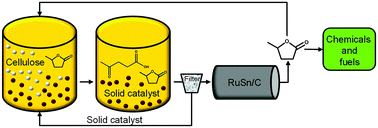Biomass is the ‘next big thing’ in chemicals production. The goal is to take cheap lignocellulosic feedstocks and convert them into high-value chemicals or even fuels.
A step in this direction has been taken by James Dumesic et al. at the University of Wisconsin-Madison, USA. They wanted to make levulinic acid (LA), a useful precursor to many kinds of industrial chemical including gamma-valerolactone (GVL), a potential green solvent and biofuel, which is also used in the perfume industry. One major problem with converting cellulose to LA is the lack of solubility of both the feedstock and the reaction’s unwanted byproducts.
Dumesic’s team used a solvent system of 90% GVL and 10% water which allowed the cellulose to be converted to fully soluble products, and prevented the precipitation of solid humin byproducts which can make catalyst separation tricky. The polymer Amberlyst 70 proved to be the best catalyst, producing 69% LA from pure cellulose after 16 h. Importantly it also performed well using a ‘real’ biomass feedstock, corn stover.
After filtration to remove the Amberlyst 70 the LA product was upgraded to GVL by hydrogenation over a ruthenium-tin catalyst, with no need for neutralisation or purification steps. This process simplification could make it a promising approach for the manufacture of added-value chemicals such as GVL from lignocellulosic biomass.
To find out more read the full article in Catalysis Science and Technology:
Direct conversion of cellulose to levulinic acid and gamma-valerolactone using solid acid catalysts
David Martin Alonso, Jean Marcel R. Gallo, Max A. Mellmer, Stephanie G. Wettsteinab and James A. Dumesic
Catal. Sci. Technol., 2013, 3, 927, DOI: 10.1039/c2cy20689g











